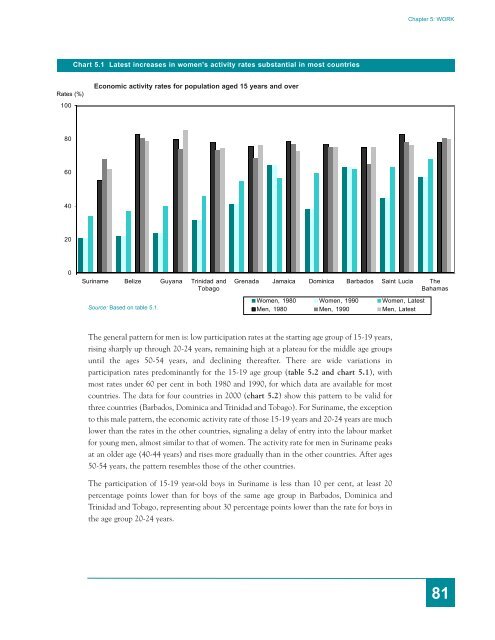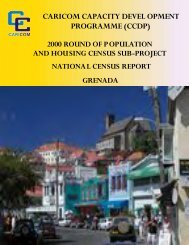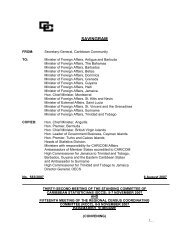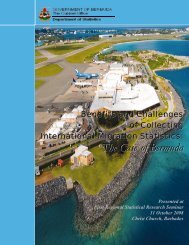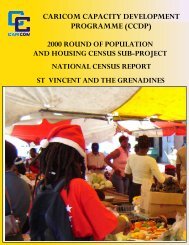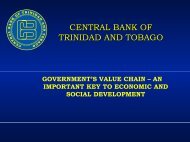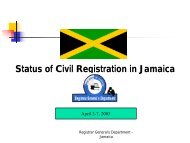Women and Men in the Caribbean Community
Facts and Figures, 1980-2001 - CARICOM Statistics
Facts and Figures, 1980-2001 - CARICOM Statistics
You also want an ePaper? Increase the reach of your titles
YUMPU automatically turns print PDFs into web optimized ePapers that Google loves.
Chapter 5: WORKChart 5.1 Latest <strong>in</strong>creases <strong>in</strong> women's activity rates substantial <strong>in</strong> most countriesRates (%)100Economic activity rates for population aged 15 years <strong>and</strong> overEconomic activity rates for population aged 15 years <strong>and</strong> over806040200Sur<strong>in</strong>ame Belize Guyana Tr<strong>in</strong>idad <strong>and</strong>TobagoSource: Based on table 5.1.Grenada Jamaica Dom<strong>in</strong>ica Barbados Sa<strong>in</strong>t Lucia TheBahamas<strong>Women</strong>, 1980 <strong>Women</strong>, 1990 <strong>Women</strong>, Latest<strong>Men</strong>, 1980 <strong>Men</strong>, 1990 <strong>Men</strong>, LatestThe general pattern for men is: low participation rates at <strong>the</strong> start<strong>in</strong>g age group of 15-19 years,ris<strong>in</strong>g sharply up through 20-24 years, rema<strong>in</strong><strong>in</strong>g high at a plateau for <strong>the</strong> middle age groupsuntil <strong>the</strong> ages 50-54 years, <strong>and</strong> decl<strong>in</strong><strong>in</strong>g <strong>the</strong>reafter. There are wide variations <strong>in</strong>participation rates predom<strong>in</strong>antly for <strong>the</strong> 15-19 age group (table 5.2 <strong>and</strong> chart 5.1), withmost rates under 60 per cent <strong>in</strong> both 1980 <strong>and</strong> 1990, for which data are available for mostcountries. The data for four countries <strong>in</strong> 2000 (chart 5.2) show this pattern to be valid forthree countries (Barbados, Dom<strong>in</strong>ica <strong>and</strong> Tr<strong>in</strong>idad <strong>and</strong> Tobago). For Sur<strong>in</strong>ame, <strong>the</strong> exceptionto this male pattern, <strong>the</strong> economic activity rate of those 15-19 years <strong>and</strong> 20-24 years are muchlower than <strong>the</strong> rates <strong>in</strong> <strong>the</strong> o<strong>the</strong>r countries, signal<strong>in</strong>g a delay of entry <strong>in</strong>to <strong>the</strong> labour marketfor young men, almost similar to that of women. The activity rate for men <strong>in</strong> Sur<strong>in</strong>ame peaksat an older age (40-44 years) <strong>and</strong> rises more gradually than <strong>in</strong> <strong>the</strong> o<strong>the</strong>r countries. After ages50-54 years, <strong>the</strong> pattern resembles those of <strong>the</strong> o<strong>the</strong>r countries.The participation of 15-19 year-old boys <strong>in</strong> Sur<strong>in</strong>ame is less than 10 per cent, at least 20percentage po<strong>in</strong>ts lower than for boys of <strong>the</strong> same age group <strong>in</strong> Barbados, Dom<strong>in</strong>ica <strong>and</strong>Tr<strong>in</strong>idad <strong>and</strong> Tobago, represent<strong>in</strong>g about 30 percentage po<strong>in</strong>ts lower than <strong>the</strong> rate for boys <strong>in</strong><strong>the</strong> age group 20-24 years.81


